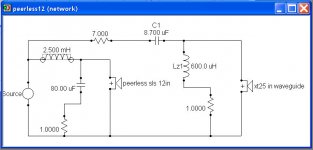Hi. Oh, it's just piece of wood glued on top of pole piece and holding copper tube
http://www.diyaudio.com/forums/showthread.php?postid=1653556#post1653556
sleeve would be better 🙂
maybe it's possible to do with thick copper foil and cheap woofer, they usually have large gaps between pole piece and coil.
http://www.diyaudio.com/forums/showthread.php?postid=1653556#post1653556
sleeve would be better 🙂
maybe it's possible to do with thick copper foil and cheap woofer, they usually have large gaps between pole piece and coil.
Did you modify (shorten) the throat of the waveguide in any way?
I'm also planning to use the XT25 and the H12RW, but the resonance at 10k (coming from the throat) is a problem to me...
I'm also planning to use the XT25 and the H12RW, but the resonance at 10k (coming from the throat) is a problem to me...
Hi. Oh, it's just piece of wood glued on top of pole piece and holding copper tube
Fast, fun, Inexpensive OB project - Page 9 - diyAudio
sleeve would be better 🙂
maybe it's possible to do with thick copper foil and cheap woofer, they usually have large gaps between pole piece and coil.
I tested this same thing. Look here: A quarter or third down
There's a chart showing inductance symmetry. The copper cup lowered inductance but increased the variance of the inductance with stroke, which is largely the distortion mechanism a shorting ring is meant to control.
I recomend you download Holm impulse this is much easier to use than speaker workshop and can do distortion measurements. See the thread for information on how to use it.
I am very interested to see how this works out.
Regards,
Andrew
I am very interested to see how this works out.
Regards,
Andrew
- Status
- Not open for further replies.
